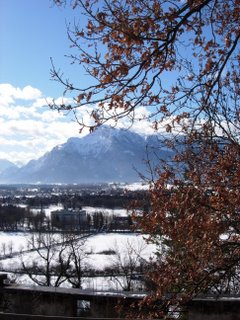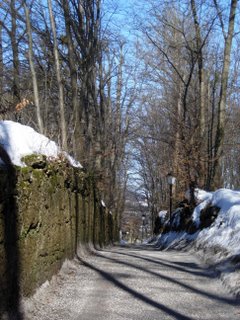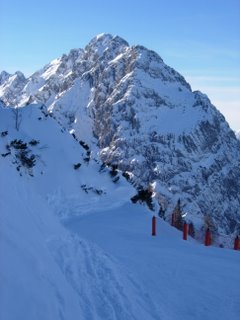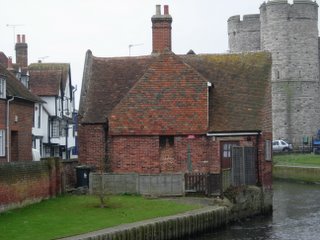Salzburg
I had forgotten to turn in my ski pass and I thought about going back over to the Hausberg base to turn it in and get the deposit back, but I figured that would take longer than was worth the five-euro deposit I put down on it. Instead I packed up and caught the next train to Innsbruck, and then on to Salzburg. This would probably have been a quicker and cheaper journey if I went back through Munich instead, but I wanted to see more of the countryside while I was in the territory.
The train runs along the length of the valley between the ridges that harbor the twin towns of Garmisch and Partenkirchen, and then passes into Austria's Tirolean Alps. The landscape was covered in white, evergreen trees hung heavy with winter's snows. Innsbruck ne
 stles in a valley, larger than the valley I had come from, but equally surrounded by slopes cut with the open swaths of ski trails. The town itself was less than exciting, at least from the inside of the train station. I had about an hour or so to wait - too short to stow my luggage and go see the town, too long to sit around. I got lunch in the train station, and tried to get hot chocolate, but was driven out of the cafe by cigarette smoke so thick I could feel my eyes getting itchy and burning. That's something I will never get used to in Europe: the cigarette smoke. People have no compunction about lighting up at the breakfast table, in the restroom, wherever. Or in this case, lighting up and tapping the ashes out into the ashtray on my table, apparently out of being too lazy to look around for the ashtray on the bar. Being from San Francisco, I'm spoiled this way. Although I'm not sure "spoiled" is the right word, since by the time I left that cafe ten minutes later, I could feel the wheezing starting up in my lungs - I'm not sure that's anything I'll ever get used to.
stles in a valley, larger than the valley I had come from, but equally surrounded by slopes cut with the open swaths of ski trails. The town itself was less than exciting, at least from the inside of the train station. I had about an hour or so to wait - too short to stow my luggage and go see the town, too long to sit around. I got lunch in the train station, and tried to get hot chocolate, but was driven out of the cafe by cigarette smoke so thick I could feel my eyes getting itchy and burning. That's something I will never get used to in Europe: the cigarette smoke. People have no compunction about lighting up at the breakfast table, in the restroom, wherever. Or in this case, lighting up and tapping the ashes out into the ashtray on my table, apparently out of being too lazy to look around for the ashtray on the bar. Being from San Francisco, I'm spoiled this way. Although I'm not sure "spoiled" is the right word, since by the time I left that cafe ten minutes later, I could feel the wheezing starting up in my lungs - I'm not sure that's anything I'll ever get used to.The train out of Innsbruck was set to arrive a little late, and by the time it actually did come in, it was close to an hour and a half past due, and dozens of chilly people were standing on the platform waiting. When it
 finally did roll into the station, I climbed on but had a hard time figuring out exactly where to sit. Some seats are reserved, some seats are tucked into glassed-in cabins but not reserved, and between all that I wasn't really sure where I was supposed to go. I finally collapsed on a seat and no one told me to move, so I didn't. I was sniffling and tired, so I just napped for the next hour or so. The gal sitting next to me turned out to speak English (though she was Dutch), and she clued me in that Salzburg might have been a better place to fly into, since Ryanair runs cheap flights in from Stansted, one of the many smaller airports that circle the suburbs of London. Good to know for next time.
finally did roll into the station, I climbed on but had a hard time figuring out exactly where to sit. Some seats are reserved, some seats are tucked into glassed-in cabins but not reserved, and between all that I wasn't really sure where I was supposed to go. I finally collapsed on a seat and no one told me to move, so I didn't. I was sniffling and tired, so I just napped for the next hour or so. The gal sitting next to me turned out to speak English (though she was Dutch), and she clued me in that Salzburg might have been a better place to fly into, since Ryanair runs cheap flights in from Stansted, one of the many smaller airports that circle the suburbs of London. Good to know for next time.The train was moving rather slow - at times I thought I could probably outrun it if I tried - so it rolled into Salzburg not too long before the sun went down. The hostel was exactly as advertised - ten minutes' walk from the train station. It was clean and comfortable and on the first night I had a room to myself. Which was good, because I still had the stuffy cough and had long since run out of sudafed and hadn't been able to locate a pharmacy to get more.
But, ten minutes' walk from any downtown train station is usually not a great part
 of town. I remember Salzburg from visits years ago, and I remember it as a cute little baroque town, cobblestone streets and narrow alleyways beneath the towering fortress perched on the peak of a steep hill. The part of town I stayed in was more like the dull industrial side that every city has but that tourists rarely visit, given what little there is to see there. I walked out to get something to eat and had trouble finding anything besides dingy-looking bars, while all around in the distance I could see the spot-lit collection of historical edifices that surround the edges of town. I finally settled on a pizza place where at least the waiter spoke enough English that I could order in a combination of broken languages, and after that I went back to the hostel and fell very fast asleep.
of town. I remember Salzburg from visits years ago, and I remember it as a cute little baroque town, cobblestone streets and narrow alleyways beneath the towering fortress perched on the peak of a steep hill. The part of town I stayed in was more like the dull industrial side that every city has but that tourists rarely visit, given what little there is to see there. I walked out to get something to eat and had trouble finding anything besides dingy-looking bars, while all around in the distance I could see the spot-lit collection of historical edifices that surround the edges of town. I finally settled on a pizza place where at least the waiter spoke enough English that I could order in a combination of broken languages, and after that I went back to the hostel and fell very fast asleep.The next morning marked my only full day in town, so I made my way to the old quarter that backs up against the ancient fortress. Here marks the place where Mozart was born, the landscap
 e that inspired The Sound of Music. I walked just about every alley and square in the old town, then started up the hill toward the fortress. But the trail was blocked by a sign I couldn't piece out - I got most of it, but one long word was lost on me. So instead I kept following the winding road I was on, which lead along a wooded ridge from which I could see two sides of town at the base of either slope. It was a sunny day and a spectacular view, surrounded by Alpine peaks studded with just wisps of cloud. I turned around to a breath-taking view back toward the fortress, and started the walk back toward town.
e that inspired The Sound of Music. I walked just about every alley and square in the old town, then started up the hill toward the fortress. But the trail was blocked by a sign I couldn't piece out - I got most of it, but one long word was lost on me. So instead I kept following the winding road I was on, which lead along a wooded ridge from which I could see two sides of town at the base of either slope. It was a sunny day and a spectacular view, surrounded by Alpine peaks studded with just wisps of cloud. I turned around to a breath-taking view back toward the fortress, and started the walk back toward town.After a couple more laps around the old city, I decided to go ahead on up to the fort
 ress. There is another way up besides the road - an old funicular that makes the near-vertical ascent from town to the old embattlement. I wandered the open areas, and finally figured out what that mysterious sign at the trailhead meant: "Danger: Roof avalanche." Which is a loose description of what happens when a thick snow starts to melt and drop off onto whatever unsuspecting passerby happens to be walking underneath. It will probably snow again before the season is out, but for now the city is in a thaw.
ress. There is another way up besides the road - an old funicular that makes the near-vertical ascent from town to the old embattlement. I wandered the open areas, and finally figured out what that mysterious sign at the trailhead meant: "Danger: Roof avalanche." Which is a loose description of what happens when a thick snow starts to melt and drop off onto whatever unsuspecting passerby happens to be walking underneath. It will probably snow again before the season is out, but for now the city is in a thaw.Inside the fortress I recognized the place where us three kids once had our picture taken perched atop a cemented-together pile of cannonballs. Just like Garmisch, there are places here that I wouldn't know that I know, and sometimes those places are startlingly familiar: at home my parents have an old picture of Bruce in profile looking toward town from along a reinforced wall edging the precipitous cliff, from this very place. I never knew where it had been taken, but it was certainly here.
After wandering the outer walls I caught up with a tour in the inner chambers, one of the stranger tours I have ever taken. At the entrance everyone was handed a hand-held radio-like device that had the text of the
 tour recorded into it in a couple dozen languages. The tour guide asked which language each person wanted, told everyone which number to dial into on the radio, and off we went into the medieval walls that now house remnants of those earlier times. Particularly notable was a set of models that showed the various stages of the fortress under construction over the many centuries, dating back to empires long fallen (to paraphrase Eddie Izzard, "Ah, the Romans were here!"). They say that the stone walls were so impenetrable that the fortress was one of very few in Europe that was never taken by force - only once did it fall into foreign hands, when it was handed over quietly to French troops during Napolean's incursion.
tour recorded into it in a couple dozen languages. The tour guide asked which language each person wanted, told everyone which number to dial into on the radio, and off we went into the medieval walls that now house remnants of those earlier times. Particularly notable was a set of models that showed the various stages of the fortress under construction over the many centuries, dating back to empires long fallen (to paraphrase Eddie Izzard, "Ah, the Romans were here!"). They say that the stone walls were so impenetrable that the fortress was one of very few in Europe that was never taken by force - only once did it fall into foreign hands, when it was handed over quietly to French troops during Napolean's incursion.The rest of the museum was an odd collection of World War I
 memorabilia and unnerving examples of medieval farm instruments turned weapons-of-war. In one spacious room, a loop of film ran in larger-than-life proportions on the blank wall, the content of which appeared to be entirely dedicated to making fun of foreign visitors, with close-ups of yawning aged yuppies in golf shirts and crowds of Asian tourists all watching through the lens of video cameras. Even stranger were the collection of metal skeletal warriors clutching scythes and pitchforks, all lunging variously toward the wall, throwing their shadows against the film in a pattern vaguely reminiscent of an old episode of Mystery Science Theater 3000. I suppose this was some kind of installation art piece, and though I'm not entirely sure what exactly it was meant to imply, it was, uh, memorable.
memorabilia and unnerving examples of medieval farm instruments turned weapons-of-war. In one spacious room, a loop of film ran in larger-than-life proportions on the blank wall, the content of which appeared to be entirely dedicated to making fun of foreign visitors, with close-ups of yawning aged yuppies in golf shirts and crowds of Asian tourists all watching through the lens of video cameras. Even stranger were the collection of metal skeletal warriors clutching scythes and pitchforks, all lunging variously toward the wall, throwing their shadows against the film in a pattern vaguely reminiscent of an old episode of Mystery Science Theater 3000. I suppose this was some kind of installation art piece, and though I'm not entirely sure what exactly it was meant to imply, it was, uh, memorable.I got seafood
 for dinner then headed back in the direction of the hostel after the sun was down. I was lying on my bunk reading when my new roommates appeared - two American girls from small-town Missouri, just a little over college aged, who were completing a student teaching gig at an army base in Bomberg, Germany. We exchanged stories for a couple of hours - everything from teaching to living on army bases to traveling around Europe - before I fell asleep, hoping my lingering cough didn't keep everyone else in the room awake.
for dinner then headed back in the direction of the hostel after the sun was down. I was lying on my bunk reading when my new roommates appeared - two American girls from small-town Missouri, just a little over college aged, who were completing a student teaching gig at an army base in Bomberg, Germany. We exchanged stories for a couple of hours - everything from teaching to living on army bases to traveling around Europe - before I fell asleep, hoping my lingering cough didn't keep everyone else in the room awake.The next morning I packed while the two roommates slept in, and I was on a train before noon. Back to Munich.

































